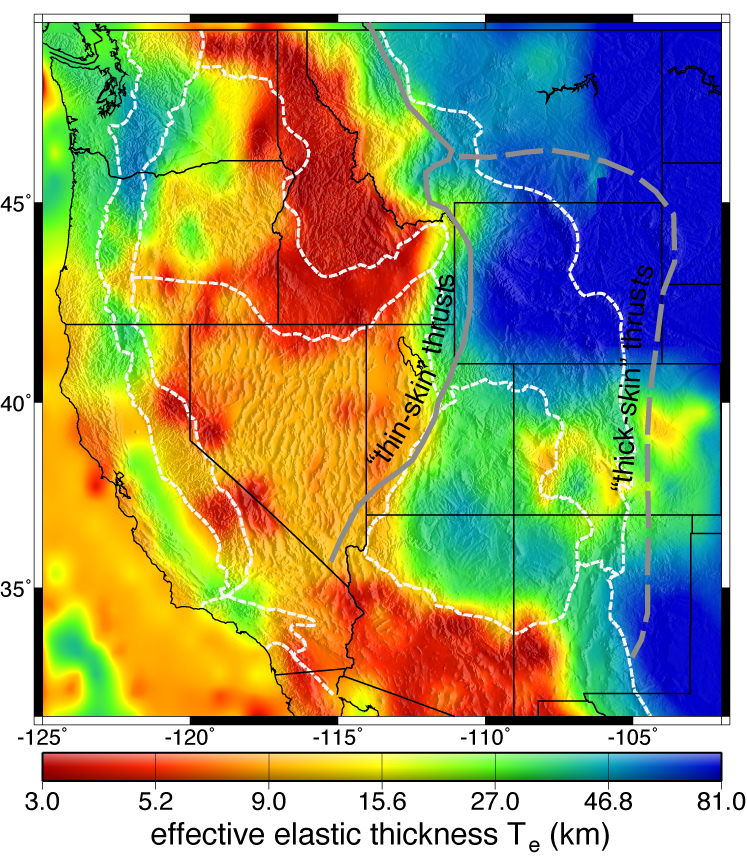|

Effective elastic thickness, a measure of lithospheric strength, in the western US
Cordillera [Lowry & Pérez-Gussinyé, 2011]. This is essentially an
integral of bending strength derived from multi-windowed, multitaper spectral analysis
of the coherence of Bouguer gravity and topography. The solid line approximates the
(pre-Oligocene) eastern limit of Sevier thin-skin thrusting; the dashed line delimits
Laramide thick-skin tectonism. Thin-skin thrusts are limited to regions where the
mantle lithosphere contributes negligibly to total strength.
|
Interest in characterizing the flow rheology of the crust and
uppermost mantle is growing rapidly within the geodesy and geodynamics
communities. We have been investigating methods for estimating
depth-dependent lithospheric viscosity for some time now, using data
that include observations of effective elastic thickness
Te from the isostatic relationship between gravity
and topography [Lowry and Smith, 1994; 1995;
Lowry et al., 2000; Pérez-Gussinyé et al.,
2004;
2007,
2008,
2009a, 2009b], from geodetic measurements of postseismic rebound
[
Paul et al., 2007; 2011], and most recently from modeling shoreline
deformation of Pleistocene Lake Bonneville.
In the past several years, we've added seismic imaging and new approaches to geotherm modeling
to our tools for estimation of physical properties. These new tools have led
to the serendipitous discovery that
the bulk crustal abundance of quartz may control continental deformation.
Investigative directions include:
Is lithospheric flow strength compositionally controlled?
Structural geologists have long noted phenomena such as "basin
inversion" and "reactivation" which suggest that deformational
strength can be inherited. This is sometimes ascribed to weakening by
faults, but faults respond passively to near-surface strain
moments originating from flow in the ductile regime, and must inevitably form
wherever those strain moments arise. (This is readily
observed, for example, at evolving plate boundaries such as the
Marlborough region of South Island New Zealand: New major faults will
develop when the locus of deeper deformation shifts by as little as 15
to 20 km). As inheritance sometimes occurs across time scales
exceeding that for thermal re-equilibration of the lithosphere, flow
strength should be partially controlled by a less transient field than
temperature. The relationship of elastic thickness
Te to heat flow Qs in the western
U.S. strongly suggested that a compositional control on ductile flow
rheology is required to explain the differences in strength of stable
versus deforming lithosphere [
Lowry et al., 2000]. This was suggested previously based on
large variations in Te over short distances [Lowry &
Smith, 1994; 1995], but these early studies inferred a compositional
variation in the mantle was responsible. New seismic imaging of the
crust in the western US Cordillera indicates that
quartz abundance in
the crust is a more likely candidate compositional mechanism for inheritance
[
Lowry & Pérez-Gussinyé, 2011], and that the weakness of quartz-rich
crust is amplified throughout the lithosphere by deformation-induced processes
that warm and wet the lithospheric column.
Why is Te from spectral models different than from
rebound studies?
Geodetic studies of western U.S. postseismic rebound and lake loading
rebound, which model the Earth as an elastic layer over a viscoelastic
halfspace, typically yield elastic layer thicknesses approximately
equal to the crustal thickness (30–40 km) and low
(<5X1019 Pa s) uppermost mantle viscosity. Coherence
analysis of gravity and topography at the same locations give
Te a factor of 4 to 6 smaller, however. Part, but
not all, of the Te difference can be explained by
the difference in timescale of loading
(100–104 years for rebound versus
106–108 years for gravity and topography).
The rest of the discrepancy suggests a problem with one or both
modeling techniques.
Recent efforts to carefully examine the sensitivities and
assumptions of the spectral isostatic analysis methodology have focused
on recovery of Te from simulated data. Efforts by our
collaborators, Marta
Pérez-Gussinyé at the Royal Holloway, University of London, and
Jon Kirby & Chris Swain at Curtin
University of Technology (Perth, Australia) have demonstrated that many long-held
concerns about methodological assumptions regarding the nature of loading and
possible effects of dynamical processes are either unfounded or can be
recognized in the course of analysis. USU MSc candidate Lisa Seunarine is
currently taking the method a step further by incorporating seismic data as an
independent constraint on mass load structure, thus obviating the need to make
assumptions about correlation properties of loading processes.
USU MSc candidate Eric Beard is simultaneously examining the limitations and
assumptions of Pleistocene Lake Bonneville rebound models. He is currently adding to
the (ca. 1980 Curry) estimates of lakeshore uplift using modern geodetic and
topographic data (and with the aid of new signal analysis tools). Once that phase
of the project is completed, he will examine the effects of a more realistic (i.e.,
temperature dependent, compositionally layered, and power-law stress-dependent)
viscosity structure. MSc candidate Anamitra De is also examining the effects of
more realistic rheology and pre-existing state of stress on postseismic rebound, and
assessing whether the combination of long-term isostatic models and
geodetic data can be used to separate effects of viscoelastic,
poroelastic and rate-state-dependent frictional response in postseismic
rebound models. Our earlier results from the
Andaman Islands indicated that most of the near-field postseismic
deformation in the first two years following the 2004 Great Sumatra/Andaman
earthquake results from fault slip [Paul et al., 2007]. More recent
results indicate that slip still dominates the near-field signature six
years after the event, suggesting that near-field postseismic rebound will be
far more useful for constraining fault
frictional rheology than for deeper flow rheology.
|


